Review: The Last Thing Mary Saw – “A slow-burning cinematic experience rich in both style and substance”
Debuts are no easy feat, that’s why filmmaker Edoardo Vitaletti deserves extra credit for choosing to tackle a disturbing period horror/thriller with queer themes as his first feature-length film. Despite some minor pitfalls that come with the job, his ambition has paid off remarkably: The Last Thing Mary Saw is the kind of slow-burning cinematic experience rich in both style and substance, building up tension to eventually reward those patient audiences who are willing to be taken on an immersive journey.
Over black, a quote from John Calvin reads: “All events whatsoever are governed by the secret counsel of God”, setting the tone of the world we’re about to enter and spend the next unsettling ninety minutes in. The year is 1843 and the place is Southold, in New York State, a town founded by Puritans in 1640. The landscape is stark and barren, the farm where the family at the centre of our story lives is somber and looks haunted from the very first establishing shot, oozing with creepy vibes straight out of The Conjuring.
Blindfolded and with blood trickling down her cheeks, the titular Mary, portrayed with effortless vulnerability by Stefanie Scott (Insidious: Chapter 3), is being interrogated by a constable regarding the sudden passing of her grandmother under mysterious circumstances and the tragic events that followed suit, leading up to her arrest in such a gory state.
We immediately find out that her illicit affair with the housemaid Eleanor (Orphan’s Isabelle Fuhrman) is what’s shaken the obsessively devout family at its core. After all, the young girls have not gone out of their way to keep their mutual attraction under the radar, prompting Mary’s father to seek counsel from the family’s matriarch, aka the now-deceased grandmother, played by iconic Judith Roberts (Eraserhead, You Were Never Really Here).
The stern and spectral old lady suggests that the maid must be moved to another household to break the cycle of temptation but only after both girls are forced into correction. The torturous practice chosen to handle the matter entails kneeling on rice for hours whilst reciting prayers. It doesn’t take long for Eleanor to crack under pressure and shamefully confess she doesn’t know all the verses, which obviously means it will take more than one session to atone for their sins.
As Mary recollects what happened, this familiar storytelling frame of investigative questioning is only the first layer encasing the film’s structure. The promising writer/director has in fact concocted a quasi-meta, matryoshka-like, circular narrative that involves a mysterious book that somebody has brought into the farm – the kind of action that’s clearly forbidden in a Puritan household where the only text allowed is the Good Book.
The film itself is split into three chapters with titles mirroring those in the sinful book and without delving into spoiler territory, suffice to say that this narrative device is pivotal to unravel the central mystery and it’s also a compelling puzzle to lose yourself into, not takings things for granted and remaining open-minded to your own interpretation by the time we reach the epilogue. That’s one of the greatest merits of Vitaletti’s approach. He doesn’t spoon-feed us any information and relies more on the unseen and the unsaid to entice our curiosity.
As the two young lovers ponder their next move to escape the bleak fate of ineluctable separation, it becomes more and more apparent that supernatural forces are at play within this claustrophobic, cult-like house of repression they are trapped in. The death of Mary’s grandmother kicks things into horror gear but the arrival of an enigmatic stranger with a birthmark disfiguring his face – played with incredible finesse by the uber-talented, yet criminally underrated Rory Culkin – is the unnerving moment that ramps up the tension to new highs.
The Last Thing Mary Saw is not a plot-heavy or a jump-scare type of horror flick. It’s a nuanced gothic piece based on folklore, in the vein of Robert Eggers’ The Witch, thriving on subtlety and atmosphere rather than sensationalism but surely able to touch the right keys when it’s time to unleash terror that crawls under your skin. The dinner scene on the day of mourning for the matriarch’s passing, where the family is bound to a vote of silence, is a masterclass in genre filmmaking and a brilliant showcase of Edoardo Vitaletti’s promising talent directing performances and crafting visuals.
The filmmaker is aptly aided by the gorgeous cinematography work of David Kruta, who uses natural light and whose candle-lit scenes look eerily like oil paintings. This is a dark film both thematically and aesthetically and it wouldn’t really work if it wasn’t period-accurate in all the various artistic departments. Yet it’s exactly the impeccable formal execution that makes it utterly hypnotic and disturbingly so, including Keegan DeWitt’s restrained and affecting original soundtrack.
Detractors will find the story a bit thin and initially I was taken aback by how in media res the romance is introduced, almost not giving us any time to feel for these characters and their Shakespearian tragedy. However, this isn’t a straight-up period queer drama a la Portrait of a Lady on Fire or Ammonite and besides having to serve a lean and mean running time, the script inevitably needs to focus on paying off its setup. Whilst other debuts often fall victim to that, Vitaletti already shows a greater understanding of what makes a story compelling and that’s why I’m eagerly anticipating whatever he does next.
The Last Thing Mary Saw is streaming exclusively on Shudder now.











